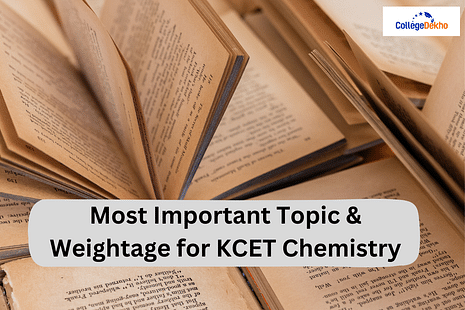
Most Important Topic & Weightage for KCET 2025 Chemistry:
Candidates who are preparing for KCET 2025 must know the important topic and the KCET chapter-wise weightage 2025 for the same. This topic would be helpful for the candidates to score good marks in KCET 2025. KCET (Karnataka Common Entrance Test) is a state-level examination. With the help of KCET, 2025 candidates can be admitted to B.Tech, BPharma, and other health sciences courses offered by the colleges in Karnataka. Candidates who are planning to give and crack the KCET 2025 should make sure to know the syllabus properly, along with the KCET chapter-wise weightage 2025 with the required study material. Here you can read the detailed syllabus for chemistry with the detailed topics below.
Chemistry is known to be a high-scoring subject, and candidates must prepare for the subject properly. According to the PUC I and PUC II syllabus, the KCET 2025 chemistry syllabus is prepared. Candidates get ideas about the subjects and their important topics through the
KCET Chemistry Syllabus Chapter Wise Topics Weightage
, and it is also said that the syllabus of Chemistry KCET 2025 is quite easy to understand without any assistance from the coaching training. Note to keep in mind while preparing for the KCET Chemistry 2025 is to practice as much as you can with the help of the previous year's question paper and give the mock test as many times as possible.
Also check:
Below in this article, we have mentioned the
KCET 2025
Chemistry syllabus with all the important topics.
KCET 2025 Chemistry Syllabus:
Name of Topic | Sub-Topics | Important Topics |
|---|---|---|
Classification of Elements and Periodicity in Properties | Periodic Trends in Properties of Elements with Reason, s/p/d/f block elements, periods, Account of Groups, Mendeleev Periodic Law, Significance of Classification, X-ray spectra of Elements (based on Henry Moseley’s observations) |
|
Some Basic Concepts of Chemistry | Reactions in Solutions, Mole and Molar Mass, Avogadro Constant, Atomic and Molecular Masses, Dalton’s Atomic Theory, General Introduction, Laws of Chemical Combination, Properties of Matter and their Measurements |
|
Redox Reactions | Oxidant/Oxidising Agent, Oxidation Number, Redox Reactions, Concept of Oxidation and Reduction, Reduction, Oxidation, Types of Redox Reactions. |
|
Thermodynamics | Enthalpy of a Reaction, Thermochemical Equations (examples), Specific Heat, Heat Capacity, Exothermic and Endothermic Reactions, Work and Heat, Surroundings, Thermodynamic Terms, Internal Energy - as a State Function, Spontaneous and Non-Spontaneous Reaction. |
|
s-Block Elements | Preparation and Properties of Some Compounds, Atomic and Ionic Radii, Hydration Enthalpy, Occurrence, Group I and II - Elements Electronic Configuration, Biological Importance of Sodium (Na) and Potassium (K), Trends in Ionization Enthalpy, Anamolous Properties of Lithium. |
|
Hydrogen | Dinitrogen, Chemical Properties, Physical Properties, Dioxygen, Reaction with Halogens, Position of Hydrogen in Periodic Table, Hydrides - Classification, Dihydrogen as a Fuel - Meaning of Hydrogen Economy. |
|
Environmental Chemistry | Green Chemistry in Day-to-Day Life, Strategies to Control Environmental Pollution, Water Pollution, Stratospheric Pollution, Environmental Pollution, Soil Pollution, Introduction to Green Chemistry, Air Pollution or Troposphere Pollution. |
|
p-Block Elements | General Introduction to p-Block Elements (Electronic Configuration), Allotropic Forms, Catenation, Group - 13 Elements, Anomalous Behaviour of First Member of Each Group, Oxidation States, Carbon - Reason and Anamolous Behaviour, Group - 14 Elements, Inert Pair Effect. |
|
Solutions | Solution of a Liquid in a Liquid, Types of Solutions, Raoult’s Law, Solution of a Solid in a Liquid, Numerical Problems to Determine Molar Mass (with the help of Colligative Properties), Abnormal Molar Mass. |
|
Solid State | Electrical Properties, Point-Defects Types, Close Packing 2-dimensional and 3-dimensional Lattices, Coordination Number, Unit Cell, Lattice Points Definition, General Characteristics of Solids - Amorphous and Crystalline Solids, Crystal Lattice, Classification Crystalline Solids. |
|
General Principles and Processes of Isolation of Elements | Extraction of Different Metals, Hydraulic Washing, Roasting and Calcination, Leaching of Alumina from Bauxite, Froth Floatation, Principles and Methods of Extraction - Concentration of Ores, Refining - Principles and Examples each for Distillation, Magnetic Separation. |
|
Surface Chemistry | Properties of Colloids - Brownian Movement & Tyndall Effect, Difference Between Absorption and Adsorption, Adsorption - Adsorbent, Adsorbate (Examples), Classification of Colloids, Catalysis - Homogenous and Heterogenous Catalysis, Physisorption and Chemisorption. |
|
Haloalkenes and Haloarenes | Reaction with Metals, Electrophilic Substitution Reactions for Chlorobenzenes, Neclueophilic Substitution Reactions, Reactions of Haloalkanes, Preparation from Alcohols, Classification Based on Hybridisation of Carbon, Optical Isomerism, Haloarenes, Elimination Reaction (β - Elimination), Physical Properties. |
|
Coordination Compounds | Stereoisomerism, Isomerism, Compare Weak Field Ligand, Crytal Field Theory (CFT), Werner’s Theory, Central of Metal Ion, Coordination Entity, Spectrochemical Series, Difference Between Double Salt and Coordination, General Introduction to Salts, Importance of Coordination compounds, Coordination Number. |
|
Organic Compounds containing Nitrogen | Diazonium Salts, Reduction of Nitrile and Amide, Methods of Preparation - Reduction of Nitrobenzene, Amines - Classification and Structure of Amines, Retention of Diazo Group, Physical and Chemical Properties. |
|
Alcohols, Phenols, and Ethers | Physical, and Chemical Properties of Primary Alcohols, Classification - All Types of Alcohols and Phenols, Preparation of Phenol, Preparation of Alcohols, Reactions of Phenol, Esterification, and Acylation of Phenols/Alcohols. |
|
Polymers | Non-biodegradable polymers, Methods of Polymerization, Classification - Structure, Source and Types of Polymerization, Macromolecule, Monomer, Polymer, Rubber, Name of Monomer/s and Partial Structure for the Polymers, Polymerization |
|
Biomolecules | Classification of ɑ - Amino Acids, Proteins, Glucose, Hormones Polysaccharides, Disaccharide, Carbohydrates-Classification based on Hydrolysis, Nucleic Acids, Vitamins, |
|
Chemistry in Everyday Life | Process of Saponification and Equation, Cleansing Agents - Soaps, Chemicals in Food - Artificial Sweetening Agents, Different Classes of Drugs - Antacids, Chemicals in Medicine - Chemotherapy, Drugs, Preservatives, etc |
|
Chemistry Important Topics for KCET 2025
The following table will help you gain knowledge about the important topics and sub-topics to help you prepare a chemistry paper:
Name of Topic | Weightage |
|---|---|
Classification of Elements and Periodicity in Properties | 08 |
Some Basic Concepts of Chemistry | 08 |
Redox Reactions | 04 |
Thermodynamics | 04 |
s-Block Elements | 06 |
Hydrogen | 03 |
Environmental Chemistry | 02 |
p-Block Elements | 07 |
Solutions | 07 |
Solid State | 07 |
General Principles and Processes of Isolation of Elements | 04 |
Surface Chemistry | 06 |
Haloalkenes and Haloarenes | 06 |
Coordination Compounds | 06 |
Organic Compounds containing Nitrogen | 05 |
Alcohols, Phenols and Ethers | 07 |
Polymers | 05 |
Biomolecules | 06 |
Chemistry in Everyday Life | 04 |
Also Read: KCET 2025 Important Topics for Physics
Chemistry books to prepare KCET 2025
Listed below are some of the relevant and popular books to prepare for the KCET 2025:
KCET Chemistry Book 2025 | Author |
|---|---|
Modern’s Abc of Chemistry, Part 1 and Part 2 | S.P. Jauhar |
NCERT books of Class 11 and 12 for Chemistry | NCERT |
Chemistry for 1st Year PUC | Prof. Somashekara Prasad |
Pradeep’s New Course Chemistry | - |
| KCET Exam Day Instructions | KCET Question Paper with Solutions PDF Download |
|---|
For more articles and updates for KCET 2025 stay tuned with Collegedekho!
Are you feeling lost and unsure about what career path to take after completing 12th standard?
Say goodbye to confusion and hello to a bright future!

FAQs
Yes, Class 12 marks do matter in the KCET (Karnataka Common Entrance Test) admission process. While the primary focus is on the performance in the KCET exam, some colleges may consider Class 12 marks as part of their admission criteria.
With a 130+ score, candidates can get a rank below 350 in the KCET exam. However, if candidates wish to get admission into some top government colleges in Karnataka, they should aim for a KCET 2025 score above 100 in the exam.
It is a known fact that there is tough competition in KCET and candidates are required to prepare well for the exam in order to qualify it. There are several ways to prepare for KCET 2025 or any competitive exam. It is the hard work and determination of a candidate which makes the way to success.
A KCET Good Score 2025 and rank in KCET 2025 depends on various factors, such as the difficulty level of the KCET exam, the number of applicants, and the cutoff trends. Generally, a score above 120 out of 180 can be considered good, but candidates should aim for scores above 150 for securing admission into the top colleges.
Yes. Only the marks secured by the candidates in the Physics, Chemistry, and Mathematics (PCM) subjects are considered for the KCET rank calculation. Candidate’s overall board exam percentage is not included. Therefore, one’s board marks equivalent for the KCET rank calculation is 60%.
NCERT books are a good source for candidates to start if they want to prepare for the KCET exam. Upon finishing the NCERT books, candidates can proceed to the other crucial KCET preparation books available in the market.
From PUC I Chemistry, the important chapters for KCET 2025 are Some Basic Concepts of Chemistry, p-Block elements, andClassification of Elements and Periodicity in Properties. But from PUC II, candidates should cover chapters such as Magnetism and Matter, Alternating Current and Electromagnetic Induction.
The KCET Chemistry syllabus covers topics such as Solid State, Phenols and Ethers, Solutions, Alcohols, Haloalkanes, Coordination Compounds, and Haloarenes, and others. For the KCET exam, students must thoroughly learn the chemical formulations.
Chapters with maximum weightage in the KCET Physics section are Gravitation, Motion in a Straight Line, Oscillations and Thermodynamics since these carry 7% to 8% weightage. Important chapters for the KCET Mathematics section include Integration, Vectors, Permutation and Combination, and 3-D Geometry. These topics weigh around 6% to 7% in the exam.
Was this article helpful?





















Similar Articles
Are GUJCET 2026 Exam Centres located only in Gujarat?
Total B.Tech Seats in IITs vs JEE Advanced Qualifiers: Is there a need to Increase Seats in IITs?
Predicted Marks Required to Score 99 Percentile in JEE Main 2026
KCET Semiconductor Electronics Weightage 2026
GUJCET vs Board Marks Weightage for Gujarat Engineering & Pharmacy Seats
What to do if you face payment issues while filling GUJCET 2026 application form?